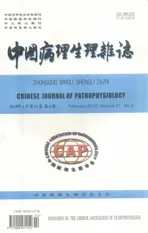地中海贫血“integration-free”诱导多能干细胞的建立及造血分化的研究*
2015-05-16蒋满波曾敏慧章钧文艳飞张滨蔡柳洪
蒋满波,曾敏慧,章钧,文艳飞,张滨,蔡柳洪△
(中山大学附属第三医院1生殖医学中心,2不育与性医学科,3产前诊断实验室,广东 广州 510630)
地中海贫血“integration-free”诱导多能干细胞的建立及造血分化的研究*
蒋满波1,2,曾敏慧1,章钧3,文艳飞1,张滨2,蔡柳洪1△
(中山大学附属第三医院1生殖医学中心,2不育与性医学科,3产前诊断实验室,广东 广州 510630)
目的:建立无外源基因整合(integration-free)的地中海贫血患者特异诱导多能干细胞(induced pluripotent stem cells,iPSC),并研究其向造血前体细胞分化的可能性。方法:用核转染的方法将表达Oct4、Sox2、Klf4、c-Myc和Lin28转录因子的质粒pEB-C5以及表达SV40大T抗原的质粒pEB-Tg导入引产巴氏水肿胎皮肤成纤维细胞中,将其重编程为iPSC后检测其向3个胚层细胞分化的特性。将iPSC细胞与小鼠OP9细胞共培养向造血前体细胞诱导分化,检测造血前体细胞特异性抗原。结果:成功建立了巴氏水肿胎皮肤成纤维细胞来源的α地中海贫血患者特异iPSC系,其具有向3个胚层分化的能力,与OP9细胞共培养9 d后可检测到造血前体细胞标记CD34的阳性率为18.7%,CD34和CD45双阳性为12.2%。结论:巴氏水肿胎皮肤成纤维细胞可成功诱导成“integration-free”iPSC,该细胞系具有向3个胚层分化的能力,与OP9共培养可向造血前体细胞分化。
地中海贫血;诱导多能干细胞;无外源基因整合;造血分化
α地中海贫血(α-thalassemia,简称α地贫)是最常见的血液系统遗传病之一,是一种常染色体遗传病,由于珠蛋白链合成不足或完全缺如,导致血红蛋白的α链与非α链比例失衡,从而使患者产生溶血性贫血表现[1]。巴氏水肿胎是α地贫纯合子,既往几乎没有希望活产或生后数天内死亡。由于技术的发展,通过宫内输血和生后持续输血治疗,也有零星报道存活的α地贫纯合子患者[2-3]。2007年人成体细胞来源的诱导多能干细胞(induced pluripotent stem cell,iPSC)建系成功[4],使患者特异的iPSC建系成为可能,而iPSC具有无限增殖和多能分化的潜能,患者特异iPSC来源的细胞自体移植不会导致免疫排斥,也没有伦理方面的问题[5],为α地贫这一类难治性遗传性疾病提供了研究致病分子机制的重要细胞模型与可能的供体细胞来源。但经典的重编程因子导入细胞基因组存在致瘤性和遗传上的风险,要应用于临床还需解决其安全性的问题。
2009 年第1例来自β地贫纯合子患者皮肤成纤维细胞的iPSC建系成功,也证明了其向造血细胞分化和产生血红蛋白的潜能[6]。此后,来自皮肤成纤维细胞、羊水细胞、绒毛膜细胞和骨髓干细胞的地中海贫血基因背景的iPSC细胞先后建系成功[7-10]。但α地贫的研究比较少。本文报道利用巴氏水肿胎引产胎儿的皮肤成纤维细胞用质粒核转染方法重编程为无外源基因整合的iPSC,并将其往造血干细胞分化,为研究α地贫提供细胞模型。
材料和方法
1 材料
DMEM高糖培养基、胎牛血清(fetal calf serum,FBS)、KnockOutTMDMEM高糖培养基、DMEM/F12培养基、N2B27培养基、Essential 8TM培养基、Knock-OutTM血清替代物(KnockOutTMSerum Replacement,KSR)、青/链霉素、L-谷氨酞胺(GlutaMAXTM-I)、非必需氨基酸(nonessential amino acids,NEAA)、β-巯基乙醇、明胶溶液、0.05%胰酶-EDTA、PBS、胶原酶IV (Invitrogen);硫代甘油(monothioglycerol,MTG)溶液和DMSO(Sigma);MEK inhibitor、GSK3β inhibitor、TGF-β inhibitor和human leukemia inhibitory factor (上海前尘生物公司);多聚甲醛和抗荧光衰减封片剂(广州义邦生物有限公司);碱性磷酸酶(alkaline phosphatase,AKP)染色试剂盒和免疫荧光试剂盒(上海斯丹赛有限公司);电转试剂盒(Lonza);质粒大量提取试剂盒(Qiangen)、缺失型α-地中海贫血基因诊断试剂盒(深圳益生堂生物企业有限公司)。质粒pEB-C5和pEB-Tg由美国Johns Hopkins大学Linzhao Cheng Lab惠赠。α地贫皮肤成纤维细胞来自基因诊断为α地贫纯合子的引产胎儿(即巴氏水肿胎),取得胎儿父母的知情同意,项目的实施获得中山大学附属第三医院生殖医学伦理委员会批准。
2 方法
2.1 细胞培养基配制按照文献记载方法配制人胚胎成纤维细胞培养基(human embryonic fibroblasts,HEF)培养基和拟胚体(embryoid body,EB)培养基[4]。配制100 mL Supplemented Fibroblast Medium(SFM):100 mL HEF培养基+100 μL HA-100 +40μL bFGF(10 mg/L),现配现用;配制250 mL N2B27培养基:238.75 mL DMEM/F12+2.5 mL N-2 supplement+5.0 mL B-27 supplement+2.5 mL NEAA+1.25 mL GlutaMAXTM-I+454.5 μL β-巯基乙醇+MEK inhibitor(0.5 μmol/L)+GSK3β inhibitor(3 μmol/L)+TGF-β inhibitor(0.5 μmol/L)+human leukemia inhibitory factor(10 μg/L)+ROCK inhibitor(10 μmol/L)+bFGF(100 μg/L);配制100 mL OP9培养基:79 mL αMEM培养基+20 mL FBS+1 mL NEAA;配制100 mL OP9/iPSC共培养培养基:90 mL αMEM+10 mL FBS+1 mL NEAA+100 μL MTG。
2.2 核转染成纤维细胞传代后培养2~3 d,转染细胞数是2×106细胞。电转缓冲液100 μL中加入4 μg pEB-C5和4 μg pEB-Tg,选择NucleofectorⅡ核转染仪的U-020程序。以试剂盒中所带绿色荧光蛋白(green fluorescent protein,GFP)质粒作为核转染的阳性对照。核转染后的细胞转移到已经铺有matrigel胶并已经加有SFM培养基的6孔板上培养过夜。核转染后第1天开始使用N2B27培养基换液,隔天换液直到第14天。核转染第15天开始使用Essential 8TM培养基换液,隔天换液,并每天观察克隆形成的情况。核转染后第21天用机械法挑取克隆转移到包被Matrigel的6孔板上培养、传代[11-12]。
2.3 细胞未分化特性检测培养5代后检测iPSC染色体,计数30个细胞,G显带。AKP染色、免疫荧光染色、畸胎瘤实验和拟胚体形成实验根据文献报道进行[4]。
2.4 造血分化与鉴定共培养前2~4 d复苏OP9细胞,接种密度为每孔1×105。共培养当天将iPSC用EDTA消化成细胞团块,用洗涤离心后接种到OP9细胞层上,每隔2 d换液1次[13-14]。在共培养第9天,流式细胞术检测CD34和CD45。
结果
1 核转染结果
核转染质粒后第1天细胞形态发生变化,细胞膨胀。在第7天出现细胞聚集类克隆样,第12天更加明显,第15天iPSC克隆呈鸟巢状集落,与未诱导成多能干细胞的成纤维细胞界限清楚,第21天克隆长大,可以机械法挑取传代,见图1。

Figure 1.Reprogramming of α-thalassemic fibroblasts.The scale bar=100 μm.a:PCR results of thalassemia detection of fibroblast cells.M:PCR marker;1:-SEA/αα positive;2:-SEA/-SEApositive;3:fetal fibroblasts(-SEA/-SEA);4:blood cells of mother(-SEA/αα).b:day 1 after transfection;c:day 7 after transfection;d:day 12 after transfection;e:day 15 after transfection;f:day 21 after transfection.图1 α地贫成纤维细胞的重编程
2 iPSC的未分化状态以及多能分化状态的鉴定
免疫荧光染色结果显示,干细胞多能性标志基因的蛋白Oct4、Sox2及干细胞特异表面抗原SSEA-4、TRA-1-60均阳性,见图2。α地中海贫血特异性诱导多功能干细胞(α-thalassemia specific induced pluripotent stem cells,α-iPSC)畸胎瘤形成结果显示肿瘤组织中包含有内、外、中3个胚层来源的组织,即血管、神经和软骨。iPSC悬滴法培养后8 d形成拟胚体;培养到第5代核型分析结果显示,iPSC仍然为正常的(46,XX)核型,见图3。

Figure 2.Immunofluorescence staining of the iPSC.The scale bar=100 μm.图2 iPSC的免疫荧光染色结果

Figure 3.Embryoid body and teratoma formation of the iPSC and karyotype determination.The scale bar=100 μm.a:AKP staining; b:embryoid body formation;c:endoderm of teratoma;d:mesoderm of teratoma;e:ectoderm of teratoma;f:the normal karyotype.图3 iPSC拟胚体及畸胎瘤的形成和核型检测
3 α-iPSC的造血分化
α-iPSC和OP9基质细胞系共培养8~10 d后收集细胞,并进行了造血标志蛋白的流式分析,结果显示CD34+造血干细胞比例为18.7%,CD34+和CD45+造血祖细胞比例为12.2%,见图4。

Figure 4.Hematopoietic differentiation of the iPSC.The scale bar=100 μm.a:OP9 cells;b:day 3 after coculture;c:day 5 after coculture;d:day 9 after coculture;e:detection of CD34 by flow cytometry;f:detection of CD34 and CD45 by flow cytometry.图4 iPSC的造血分化结果
讨论
目前将体细胞诱导为iPSC时主要还是基于2007年Yamanaka报告的4因子为主,外源基因导入细胞存在一定的致瘤性,无外源基因整合的iPSC诱导技术成为重要研究方向[15-17]。pEB-C5一个质粒能同时表达Oct4、Sox2、Klf4、c-Myc和Lin28转录因子,一次转染即可成功诱导成体外周血单核细胞和脐带血细胞诱导分化为无外源基因整合的iPSC,pEB-Tg质粒表达SV40大T抗原,与pEB-C5共转染pEB-Tg主要用于提高诱导效率[18-19]。这是基于EBNA1/oriP体系的质粒载体,当质粒导入细胞内后能够表达蛋白EBNA,EBNA随后结合在复制子oriP上,使该质粒在染色体外不经过基因组整合就可进行复制。这样就保证了由该质粒携带的诱导蛋白在整个iPSC诱导过程中得到表达,但在获得iPSC后,导入的质粒由于不整合到基因组,经过一定时间的体外培养(10~12代)之后便可逐渐失,从而得到无外源基因整合的iPSC。
人类iPSC的优势之一是细胞来源非常广泛。虽然pEB-C5和pEB-Tg主要是用于外周血细胞或者脐带血细胞的再程序化,但在这里我们同时利用pEB-C5和pEB-Tg共转染将引产巴氏水肿胎皮肤成纤维细胞成功地诱导为iPSC。免疫组化检查、碱性磷酸酶检查和畸胎瘤检查结果证实了地贫iPSC细胞的多能分化能力。
早在1994年,Nakano等[20]首次将干细胞与OP9细胞共培养获得淋巴造血细胞。2011年,Morishima等[21]则利用iPSC与OP9共培养,在细胞因子的辅助下延长培养时间至30 d,获得了与外周血中成熟中性粒细胞相似的细胞。研究表明,利用与OP9细胞共培养的方法诱导干细胞发育成为造血前体细胞,分化所需的时间短,仅需8~9 d,分化过程中无需添加细胞因子,是向造血细胞分化的简单有效的第一步[13]。
我们的研究显示,同时利用pEB-C5和pEB-Tg共转染可以将引产巴氏水肿胎皮肤成纤维细胞成功地诱导为无外源基因整合的iPSC,该细胞系为未分化状态,具有多能分化能力,与OP9共培养可以向造血细胞分化。我们的研究结果为研究α地贫提供了细胞模型。
[1]Higgs DR,Gibbons RJ.The molecular basis of alphathalassemia:a model for understanding human molecular genetics[J].Hematol Oncol Clin North Am,2010,24 (6):1033-1054.
[2]Joshi DD,Nickerson HJ,Mcmanus MJ.Hydrops fetalis caused by homozygous alpha-thalassemia and Rh antigen alloimmunization:report of a survivor and literature review[J].Clin Med Res,2004,2(4):228-232.
[3]Higgs DR,Weatherall DJ.The alpha thalassaemias[J].Cell Mol Life Sci,2009,66(7):1154-1162.
[4]Takahashi K,Tanabe K,Ohnuki M,et al.Induction of pluripotent stem cells from adult human fibroblasts by defined factors[J].Cell,2007,131(5):861-872.
[5]郭晓令,刘庆,王婵,等.重编程诱导多功能干细胞的研究进展[J].中国病理生理杂志,2014,30(7): 1218-1222.
[6]Ye L,Chang JC,Lin C,et al.Induced pluripotent stem cells offer new approach to therapy in thalassemia and sickle cell anemia and option in prenatal diagnosis in genetic diseases[J].Proc Natl Acad Sci U S A,2009,106 (24):9826-9830.
[7]Papapetrou EP,Lee G,Malani N,et al.Genomic safe harbors permit high beta-globin transgene expression in thalassemia induced pluripotent stem cells[J].Nat Biotechnol,2011,29(1):73-78.
[8]Chang CJ,Bouhassira EE.Zinc-finger nuclease-mediated correction of alpha-thalassemia in iPS cells[J].Blood,2012,120(19):3906-3914.
[9]Fan Y,Luo Y,Chen X,et al.Generation of human betathalassemia induced pluripotent stem cells from amniotic fluid cells using a single excisable lentiviral stem cell cassette[J].J Reprod Dev,2012,58(4):404-409.
[10]Ma N,Liao B,Zhang H,et al.Transcription activatorlike effector nuclease(TALEN)-mediated gene correction in integration-free beta-thalassemia induced pluripotent stem cells[J].J Biol Chem,2013,288(48):34671-34679.
[11]Fontes A,Macarthur CC,Lieu PT,et al.Generation of human-induced pluripotent stem cells(hiPSCs)using episomal vectors on defined Essential 8TMMedium conditions[J].Methods Mol Biol,2013,997:57-72.
[12]Su RJ,Baylink DJ,Neises A,et al.Efficient generation of integration-free iPS cells from human adult peripheral blood using BCL-XL together with Yamanaka factors[J].PLoS One,2013,8(5):e64496.
[13]Choi KD,Vodyanik M,Slukvin II.Hematopoietic differentiation and production of mature myeloid cells from human pluripotent stem cells[J].Nat Protoc,2011,6(3): 296-313.
[14]Lapillonne H,Kobari L,Mazurier C,et al.Red blood cell generation from human induced pluripotent stem cells: perspectives for transfusion medicine[J].Haematologica,2010,95(10):1651-1659.
[15]Zhou Q.Induced pluripotent stem cells:current progress and future perspectives[J].Genomics Proteomics Bioinformatics,2013,11(5):257-258.
[16]Wang T,Zhao HS,Zhang QL,et al.Generation of transgene-free induced pluripotent stem cells with non-viral methods[J].Chin Med Sci J,2013,28(1):50-54.
[17]Zhou YY,Zeng F.Integration-free methods for generating induced pluripotent stem cells[J].Genomics Proteomics Bioinformatics,2013,11(5):284-287.
[18]Dowey SN,Huang X,Chou BK,et al.Generation of integration-free human induced pluripotent stem cells from postnatal blood mononuclear cells by plasmid vector expression[J].Nat Protoc,2012,7(11):2013-2021.
[19]Chou BK,Mali P,Huang X,et al.Efficient human iPS cell derivation by a non-integrating plasmid from blood cells with unique epigenetic and gene expression signatures[J].Cell Res,2011,21(3):518-529.
[20]Nakano T,Kodama H,Honjo T.Generation of lymphohematopoietic cells from embryonic stem cells in culture[J].Science,1994,265(5175):1098-1101.
[21]Morishima T,Watanabe K,Niwa A,et al.Neutrophil differentiation from human-induced pluripotent stem cells[J].J Cell Physiol,2011,226(5):1283-1291.
Generation of thalassemia-specific integration-free induced pluripotent stem cells and determination of their differentiation ability
JIANG Man-bo1,2,ZENG Min-hui1,ZAHNG Jun3,WEN Yan-fei1,ZHANG bin2,CAI Liu-hong1
(1Center for Reproductive Medicine,2Department of Infertility&Sexual Medicine,3Prenatal Diagnostic Laboratory,The Third Affiliated Hospital,Sun Yat-sen University,Guangzhou 510630,China.E-mail:cailh@mail.sysu.edu.cn)
AIM:To generate thalassemia-specific integration-free induced pluripotent stem cells(iPSC)and to detect their ability of differentiation into hematopoietic precursors.METHODS:The plasmids pEB-C5 and pEB-Tg were transfected into the fibroblast cells from hemoglobin Bart’s hydrops fetalis’s skin by the method of nuclear transfection to reprogramm the cells into iPSC.The ability of the iPSC to differentiate into 3-germ layer cells was determined.The iPSC were cocultured with mouse OP9 cells to differentiate into hematopoietic precursors and the hematopoietic precursor specific antigens were detected.RESULTS:The integration-free iPSC from hemoglobin Bart’s hydrops fetalis’s skin fibroblasts were successfully derived,and had the ability to differentiate into 3 germ layers.When cocultured with OP9 cells for 9 d,the positive rate of hematopoietic progenitor cell marker CD34 was 18.7%,and the CD34 and CD45 double positive rate was 12.2%.CONCLUSION:Hemoglobin Bart’s hydrops fetalis’s skin fibroblasts can be successfully induced into“integration-free”iPSC.This cell line has the ability to differentiate into 3 germ layers,and can be differentiated into hematopoietic precursors when cocultured with OP9 cells.
Thalassemia;Induced pluripotent stem cells;Integration-free;Hematopoietic differentiation
R363;Q813.5
A
10.3969/j.issn.1000-4718.2015.02.010
1000-4718(2015)02-245-05
2014-12-30
2015-01-13
国家自然科学基金面上资助项目(No.81170533)
△通讯作者Tel:020-85256335;E-mail:cailh@mail.sysu.edu.cn
